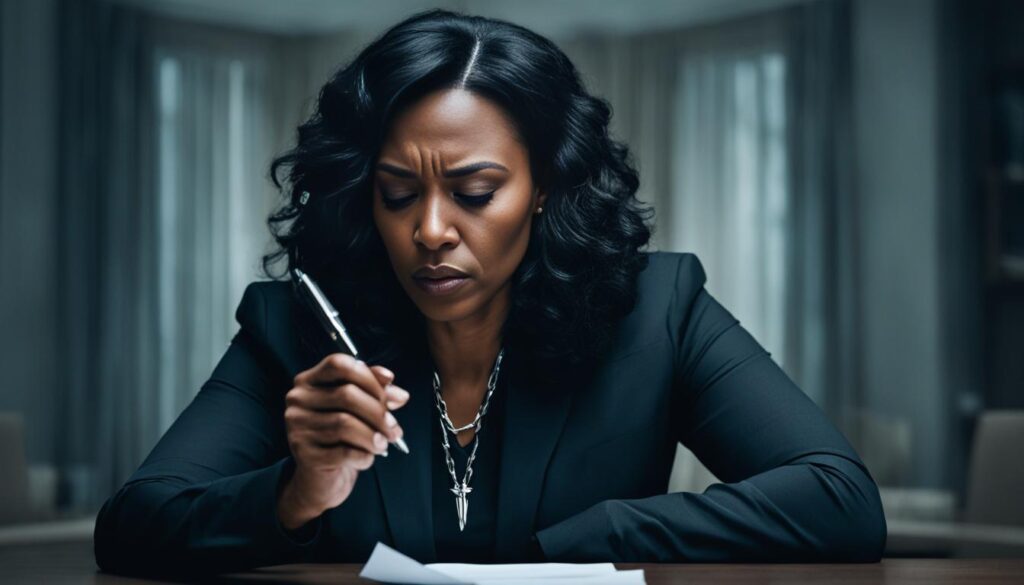“No Visible Bruises” by Rachel Louise Snyder is a powerful audiobook that sheds light on the dark reality of domestic violence, a topic seldom discussed in public. Domestic violence is a global problem affecting countless individuals, families, and communities. This section provides an insightful overview of the audiobook and its exploration of domestic violence, including the consequences for survivors and the challenges they may face in seeking justice.
Through thought-provoking analysis and real-life stories, “No Visible Bruises” exposes the hidden aspects of domestic violence and its impact on society. This audiobook review will delve deeper into the audiobook’s themes and key messages, enhancing our understanding and challenging us to take action against domestic violence.
Understanding Domestic Violence
Domestic violence is a pattern of behavior used by one partner to gain control over the other in an intimate relationship. It affects people of all ages, genders, races, and socioeconomic backgrounds, and involves physical, emotional, and psychological abuse.
The abuse cycle is a common pattern in domestic violence relationships. It typically starts with a tension-building phase where the abuser becomes increasingly agitated, leading to verbal or emotional abuse. This is followed by a violent episode, where the abuser physically harms the victim. Finally, the abuser apologizes and promises to change, leading to a period of calm before the cycle begins again.
It is important to recognize the signs of domestic violence and seek help if you or someone you know is experiencing abuse. These signs include physical injuries, isolation from friends and family, changes in behavior or personality, and financial control.
The Impact of Domestic Violence
The consequences of domestic violence can be severe and long-lasting. Victims may experience physical injuries, chronic health conditions, and emotional trauma. Domestic violence can also lead to financial insecurity, housing instability, and social isolation. Children who witness domestic violence may suffer from developmental delays, behavioral problems, and poor academic performance.
| Consequences of domestic violence | Impact |
|---|---|
| Physical injuries | Bruises, broken bones, head trauma, internal injuries |
| Emotional trauma | Depression, anxiety, PTSD, suicide |
| Financial insecurity | Loss of income, job instability, debt, poverty |
| Housing instability | Homelessness, fear of eviction, lack of safe housing options |
It is important to provide support and resources for survivors of domestic violence to help them heal and recover from the trauma they have experienced.
The Impact of Domestic Violence
Domestic violence not only affects the immediate targets of abuse but also has far-reaching consequences on the wider community. The emotional trauma experienced by survivors frequently leads to conditions such as anxiety, depression, and post-traumatic stress disorder (PTSD), affecting their ability to work, preserve relationships, and thrive in society. Children who witness domestic violence often suffer from emotional and mental health problems, affecting their education and future prospects. Victims of domestic violence are also at a higher risk of substance abuse and suicide.
According to a National Intimate Partner and Sexual Violence Survey, women who experienced domestic violence were more likely to develop chronic health conditions, such as heart disease, asthma, and diabetes. The economic burden of domestic violence is also significant, including healthcare costs, lost productivity, and criminal justice expenses.
Preventing domestic violence is crucial for the mental and physical well-being of individuals and the community at large. Support services such as counseling, legal aid, and safe shelters can aid victims in leaving abusive relationships, while prevention programs, and education on healthy relationships can help to change societal attitudes towards domestic violence.
Exploring the Hidden Aspects
Domestic violence isn’t always visible. Perpetrators use subtle tactics to manipulate and control their victims. Recognizing hidden signs of abuse is crucial in identifying and preventing domestic violence.
Psychological manipulation is one such tactic that abusers use to gain power over their victims. Gaslighting, victim-blaming, and shifting responsibility are all forms of psychological manipulation that can make the victim feel like they are going crazy or responsible for the abuse.
To further understand the subtleties of abuse, the below table outlines some lesser-known signs of abusive behavior:

It’s important to remember that abuse is never the victim’s fault and that recognizing the signs and seeking help is crucial in breaking the cycle of abuse.
Breaking the Silence
Domestic violence is a widely prevalent issue that affects millions of people worldwide, yet it remains shrouded in secrecy and shame. Speaking out against abuse and empowering survivors to break the silence are essential steps in addressing this problem.
Survivors of domestic violence often feel isolated and alone, with little support or understanding from family, friends, or society at large. By raising awareness and encouraging open dialogue about domestic violence, we can help to break down the barriers of silence and shame and create a culture of support and understanding.
Empowering survivors to speak out and seek help is another crucial aspect of addressing domestic violence. This can involve providing access to support services such as counseling, legal aid, and safe housing, as well as supporting survivors in rebuilding their lives after trauma.
Breaking the silence surrounding domestic violence requires a collective effort from individuals, communities, and institutions. By working together to raise awareness, support survivors, and hold perpetrators accountable, we can create a safer, more just society for everyone.
The Role of Institutions
Domestic violence cases often require a systemic response from institutions such as law enforcement, healthcare, and social services. These organizations play a critical role not only in responding to domestic violence incidents but also in providing support services to survivors and addressing the root causes of abuse.
Support services include hotlines, shelters, and counseling services to help survivors recover from trauma and rebuild their lives. However, it can be challenging for survivors to navigate the complex and often fragmented support system.
Law Enforcement
Law enforcement agencies are typically the first responders to domestic violence incidents. While some officers are trained to identify and respond to domestic violence, others lack the necessary training and may not take the allegations seriously. This can result in inadequate responses and further harm to survivors.
| Pros | Cons |
|---|---|
| Ability to offer immediate assistance and protection | Lack of training and resources to respond effectively |
| Legal power to arrest and prosecute perpetrators | Limited understanding of the complexity of domestic violence cases |
| Ability to connect survivors with support services | Fear of retaliation may prevent survivors from reporting abuse |
Healthcare
Healthcare providers also play a crucial role in identifying and responding to domestic violence. They can offer medical care and document injuries sustained during abuse.
| Pros | Cons |
|---|---|
| Familiarity with the signs and symptoms of abuse | Lack of training to screen for domestic violence |
| Opportunity to provide resources and referrals to survivors | Limited time and resources to address complex cases |
| Ability to document injuries and provide evidence for legal cases | Fear of breaching confidentiality and jeopardizing the survivor’s safety |
Social Services
Social services such as child welfare agencies and domestic violence shelters also provide critical support services to survivors of domestic violence.
| Pros | Cons |
|---|---|
| Expertise in providing support and resources to survivors | Overcrowded shelter facilities and limited resources |
| Ability to provide counseling services and legal advocacy | Bureaucratic hurdles and red tape can make it difficult to access services |
| Opportunity to connect survivors with community resources | Insufficient funding to provide comprehensive support services |
It is crucial for institutions to collaborate and coordinate their efforts to improve the systemic response to domestic violence and address the needs of survivors.
Legal Protections and Challenges
Survivors of domestic violence may seek legal remedies to protect themselves from further harm. Restraining orders, also known as protective orders or orders of protection, are a common legal mechanism used to prohibit an abuser from contacting or approaching a survivor. These orders can offer a sense of safety and security, but their effectiveness can be limited by a variety of challenges.
The legal process of obtaining a restraining order can be complicated and time-consuming, requiring survivors to navigate complex court systems and provide evidence of abuse. Additionally, abusers may violate these orders, leaving survivors in ongoing danger. It is crucial for survivors to have access to legal support and resources to help them navigate these challenges.
Legal remedies can also include civil lawsuits or criminal charges against abusers. These options aim to hold perpetrators accountable for their actions and provide survivors with justice and restitution. However, survivors may face additional obstacles in pursuing legal action, such as financial barriers or fear of retaliation. Encouraging a supportive and understanding environment for survivors is necessary to ensure their safety and access to justice.

| Type of Restraining Order | Description |
|---|---|
| Emergency Protective Order | Issued by police or judges to provide immediate protections for survivors in situations of imminent danger. |
| Temporary Restraining Order | Grants survivors protection for a limited time period until a hearing can be held to determine if a permanent restraining order is necessary. |
| Permanent Restraining Order | Issued after a court hearing and provides long-term protection for survivors. Violations of a permanent restraining order can result in arrest and criminal charges. |
The Importance of Legal Protections
Legal protections such as restraining orders and civil or criminal charges are essential tools for survivors of domestic violence to safeguard themselves and seek justice. However, it is crucial to acknowledge the challenges survivors may face in accessing these remedies and ensure they have access to resources and support. By promoting a comprehensive approach that includes legal protections, advocacy, and prevention efforts, we can work towards a future where domestic violence is no longer tolerated in our society.
Intersectionality and Domestic Violence
Domestic violence is a pervasive issue that affects individuals of all races, genders, and socioeconomic backgrounds. However, it disproportionately impacts marginalized communities, where individuals may face additional barriers to seeking help and safety.
Gender-based violence is a significant aspect of domestic violence that affects women and non-binary individuals. Studies have shown that women of color, LGBTQ+ individuals, and disabled women experience higher rates of domestic violence than their counterparts.
| Domestic Violence Rates | |
|---|---|
| Black Women | 2.5 times higher than white women |
| Native American/Alaska Native Women | 2.5 times higher than any race |
| LGBTQ+ Individuals | 44% experience domestic violence in their lifetime |
These statistics highlight the importance of acknowledging the intersectional aspects of domestic violence and providing support and resources to marginalized communities. It’s crucial to address the root causes of domestic violence, including systemic oppression and inequality that perpetuate violence and trauma.
By centering the experiences and voices of marginalized communities, we can work towards a future where domestic violence is no longer tolerated or normalized.
Innovative Approaches to Prevention
Preventing domestic violence requires a multifaceted approach that addresses the root causes of the problem, empowers individuals and communities, and promotes healthy relationships. In recent years, there have been several innovative prevention programs and initiatives aimed at tackling domestic violence head-on.
The Green Dot Program
One such program is the Green Dot Program, which was developed by Dorothy Edwards and focuses on bystander intervention. The program emphasizes the role of individuals in preventing violence and encourages them to intervene if they witness a potentially violent situation. By empowering bystanders to act, the program aims to create a culture of intolerance towards domestic violence.
Healthy Relationships Curriculum
Education on healthy relationships can also be highly effective in preventing domestic violence. The Healthy Relationships Curriculum, developed by the Idaho Coalition Against Sexual and Domestic Violence, is designed to teach young people about healthy relationships, consent, boundaries, and communication. By equipping young people with these essential skills, the program aims to prevent domestic violence before it can occur.
Tech-Based Prevention
Advancements in technology have also led to the development of innovative prevention strategies. For example, the Aspire News App is a smartphone app that provides domestic violence resources and support, as well as a discreet way for survivors to call for help. Another example is the Circle of 6 App, which allows users to reach out to their circle of trusted friends and family for help if they feel they are in danger.
By embracing innovative prevention programs like these, we can work towards a future free from domestic violence.
Healing and Recovery
Survivors of domestic violence often face lasting emotional and psychological scars. Trauma-informed care and therapeutic interventions are essential in helping survivors heal and recover from their experiences.
Trauma-informed care is an approach that recognizes the pervasive and long-lasting impact of traumatic experiences on individuals. It focuses on creating a safe and supportive environment that recognizes the survivor’s needs and empowers them in their healing process. This involves fostering a sense of trust, mutual respect, and collaboration between the survivor and their healthcare providers.
Therapeutic interventions, such as individual or group counseling, can help survivors address their emotional trauma and develop coping mechanisms to manage their symptoms. Cognitive-behavioral therapy and other evidence-based therapies have demonstrated efficacy in treating symptoms of post-traumatic stress disorder, anxiety, and depression that commonly affect survivors of domestic violence.
Benefits of Trauma-informed care and Therapeutic interventions
| Benefits of Trauma-informed care | Benefits of Therapeutic interventions |
|---|---|
| Helps survivors feel respected, empowered, and validated | Teaches coping mechanisms to manage emotional trauma symptoms |
| Fosters healing through a safe and supportive environment | Promotes communication and introspection, leading to behavior change |
| Reduces the risk of re-traumatization | Supports improved relationships and interpersonal communication skills |
Trauma-informed care and therapeutic interventions can be integral to a survivor’s healing process and effectively managing their mental health. By prioritizing the survivor’s needs and empowering them in the healing process, healthcare providers can contribute to the prevention of further harm and promote a healthier community.
Advocacy for Change
To effectively address domestic violence, systemic change is necessary. This change can be brought about through advocacy and activism, which can influence domestic violence policy and improve support services for survivors. Activists and advocates for change can utilize various platforms and tactics, such as social media campaigns, lobbying for legislative changes, and organizing protests and rallies.
It is important to ensure that domestic violence policy is not only focused on punitive measures for perpetrators but also on preventative measures and the provision of support services for survivors. This can include increased funding for shelters, hotlines, counseling, and legal aid. By prioritizing survivor-centered approaches and engaging in advocacy efforts, we can work towards a future where domestic violence is no longer a pervasive societal issue.
Examples of Activism for Domestic Violence Policy Change
| Activist/Group | Tactic/Initiative |
|---|---|
| The National Coalition Against Domestic Violence (NCADV) | Efforts to advocate for domestic violence-informed policies and practices across systems including child welfare, healthcare, and criminal justice. |
| The Me Too Movement | Spurred conversations around sexual assault and domestic violence, leading to widespread policy change including the introduction of mandatory sexual harassment training at workplaces and the implementation of trauma-informed practices in schools. |
| The Purple Purse Foundation | Raises awareness and funds to support survivors of domestic violence through initiatives such as the Purple Purse Challenge, a fundraising competition for domestic violence organizations. |
Real-Life Stories: Understanding the Impact of Domestic Violence
To truly comprehend the severity and impact of domestic violence, it is essential to examine the real-life experiences of survivors. These brave individuals have shared their stories in the hopes of breaking the stigma and silence surrounding domestic violence.
One survivor, Mandy*, shared her story of emotional abuse and manipulation by her partner. Gaslighting and isolation tactics were used to make her feel trapped. However, with the help of a support group and therapy, Mandy was able to leave the toxic relationship and start her healing journey.
Another survivor, Mark*, shared his experience of physical and emotional abuse by his wife. He felt embarrassed and ashamed to share his story, as he felt that the public perception of domestic violence portrayed men as the perpetrators, not victims. However, with the help of a men’s support group, Mark was able to leave the abusive relationship and get the help he needed to heal.
These stories and many others highlight the devastating impact of domestic violence on individuals and families. It is crucial to empathize with survivors and support them on their healing journey.
Critical Reception of “No Visible Bruises”
“No Visible Bruises” by Rachel Louise Snyder has received widespread critical acclaim for its thought-provoking exploration of domestic violence. Numerous book reviews have described Snyder’s work as a powerful and necessary contribution to the public discourse on this important issue.
“A Must-Read for Anyone Seeking to Understand Domestic Violence”
The New York Times called “No Visible Bruises” a “must-read for anyone seeking to understand domestic violence” and praised Snyder for her comprehensive research and empathetic portrayal of survivors. The newspaper noted that Snyder’s work sheds light on the “quiet, insidious, everyday violence” that often goes unnoticed.
“A Vital Resource for Survivors and Advocates”
The Los Angeles Times hailed “No Visible Bruises” as a “vital resource for survivors and advocates” and praised Snyder for her “unflinching look” at the impact of domestic violence on individuals and communities. The newspaper also noted that Snyder’s work provides useful insights into the systemic responses to domestic violence and the challenges faced by survivors seeking legal remedies.
“A Call to Action for All of Us”
NPR praised “No Visible Bruises” for its “lucid prose” and “tremendous urgency,” calling it a “call to action for all of us.” The review noted that Snyder’s work provides valuable insights into the “pervasive, systemic nature of domestic violence” and its impact on every aspect of society.
“An Essential Read for Anyone Who Cares About Justice”
The Washington Post described “No Visible Bruises” as an “essential read for anyone who cares about justice” and praised Snyder for her rigorous reporting and attention to detail. The newspaper also noted that Snyder’s work challenges readers to reconsider their assumptions about domestic violence and its impact on individuals and society.
Conclusion
Domestic violence is a widespread issue that affects individuals and communities across the world. Rachel Louise Snyder’s “No Visible Bruises” provides a powerful exploration of this complex topic, shedding light on its hidden aspects and the wide-ranging impacts it can have on survivors.
Through examining the nature of domestic violence, its consequences, and the innovative approaches being taken to prevent and address it, Snyder’s work highlights the urgent need for us to collectively address this issue. We must break down the stigma and silence surrounding domestic violence, and empower survivors to speak out and seek justice.
It is only through a concerted effort, involving institutions, policymakers, and individuals across society, that we can hope to bring about meaningful change. As we continue to work towards this goal, we should draw inspiration from the stories and experiences shared in “No Visible Bruises” and commit ourselves to creating a safer, more just world for all.
FAQ
What is “No Visible Bruises: What We Don’t Know About Domestic Violence Can Kill Us” about?
“No Visible Bruises” is an audiobook by Rachel Louise Snyder that explores the topic of domestic violence and delves into the lesser-known aspects of this issue.
What does the audiobook discuss regarding domestic violence?
The audiobook examines various aspects of domestic violence, including the cycle of abuse, its consequences on individuals and communities, hidden signs of abuse, and the psychological manipulation employed by perpetrators.
Why is it important to raise awareness about domestic violence?
Raising awareness about domestic violence plays a crucial role in breaking the silence surrounding abuse and empowering survivors to speak out against it. It helps society understand the magnitude of the problem and work towards prevention and support for those affected.
How do institutions respond to domestic violence cases?
The book explores the response of institutions such as law enforcement, healthcare, and social services to domestic violence cases. It examines the systemic approach and support services available to survivors.
What legal protections are available for survivors?
The audiobook discusses the legal protections available to survivors, including restraining orders and other legal remedies. It also acknowledges the challenges survivors may face in seeking justice.
Does domestic violence affect specific communities differently?
Yes, domestic violence affects different communities differently, and the book highlights the intersectional aspects of this issue. It delves into how domestic violence impacts marginalized communities and looks at gender-based violence.
Are there any innovative approaches to prevent domestic violence?
The book explores innovative approaches and prevention programs aimed at preventing domestic violence, educating individuals about healthy relationships, and promoting early intervention.
How important is healing and recovery for survivors of domestic violence?
Healing and recovery are crucial for survivors of domestic violence. The book emphasizes the importance of trauma-informed care and therapeutic interventions in supporting survivors on their journey to healing.
How can advocacy and activism bring about change in addressing domestic violence?
Advocacy and activism play a significant role in driving systemic change to address domestic violence. The book discusses the power of advocacy and how it can influence domestic violence policies and encourage activism to create lasting change.
Are there any real-life case studies or survivors’ experiences shared in the book?
Yes, the book shares real-life case studies and survivors’ experiences to provide a deeper understanding of domestic violence and its impact. These stories humanize the issue and shed light on the realities survivors face.
How has “No Visible Bruises” been received by audiences?
The critical reception of Rachel Louise Snyder’s audiobook “No Visible Bruises” has been positive, with many praising its thought-provoking and impactful exploration of domestic violence. It has sparked important discussions and contributed to the public discourse surrounding this issue.



